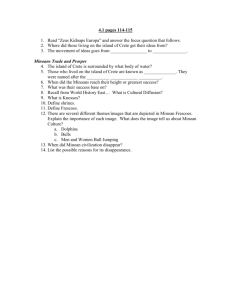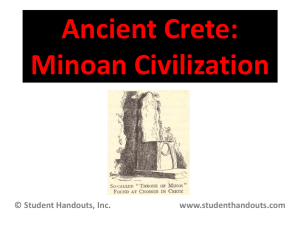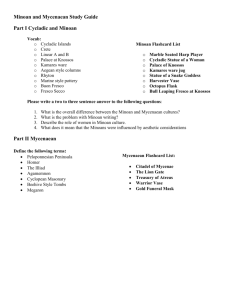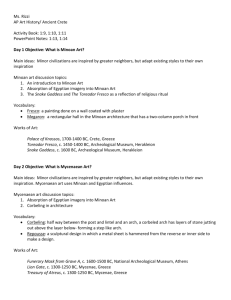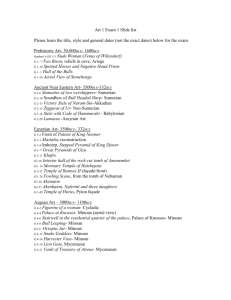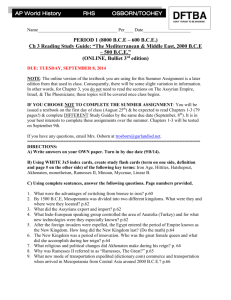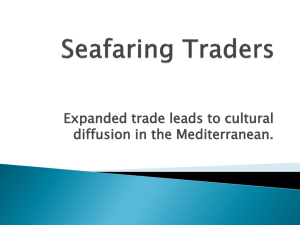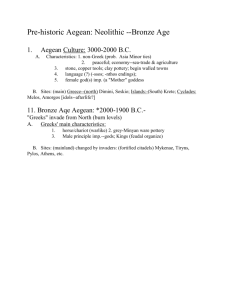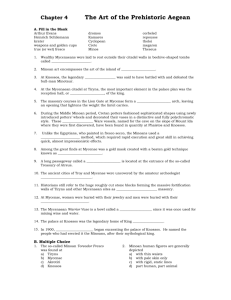MINOAN ART
advertisement
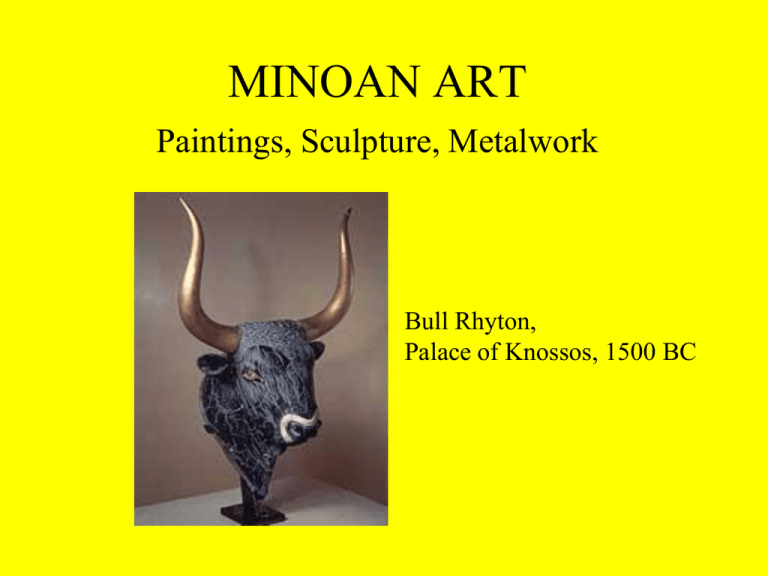
MINOAN ART Paintings, Sculpture, Metalwork Bull Rhyton, Palace of Knossos, 1500 BC Minoan Art • Introduction: – Minoan art reveals much about that society: • Joyous people • In touch with their environment/nature • In awe of movement – Minoan art is fluid – Minoan art was produced for its beauty rather than function. • Most art had a political or religious function. So did Minoan to an extent. But, lots of their art is for arts sake. Minoan Art Gold Ring, 2000 BC • Many types: Early Minoan I/II 2500 BC Snake Goddess 1600 BC Spectators Fresco, Knossos, 1450 BC Minoan Art – Minoan art frequently involved trivial details of everyday life: cat stalking prey, octopus, sporting events rather than battles or political events. – This is art done out of interest in everyday life. – Most depictions of humans represent them them in the less meaningful events of life: walking, carrying a vase, etc. Minoan Art • Everyday Life: Water Bearers, Knossos, 1400 BC The Fisherman, Akrotiri, 1500 BC Minoan Art – This is the great Minoan legacy: producing art for pleasure. Art for arts sake. This led to a revolution in Greek art later on. – Minoan artist catches his subjects in the midst of action. Minoan Art The Boxers: • Subjects in action: The Dolphins, Palace of Knossos, 1600 BC Akrotiri, 1600 BC Minoan Art • History: – Not much survives from the early Minoan period • First palaces built – Much art from the Middle Minoan period (1900-1700 BC). – Art reached its zenith during the late Minoan period – But also declined during the late Minoan period. Minoan Art • POTTERY: – Proto-palatial (middle Minoan) 2000-1600: introduction of potters wheel. Pottery now had thin walls and symmetrical shapes. Minoan Art • Chronology of Pottery: – Monochrome neolithic wares: until EM period. – Early Minoan Period: pottery decorated with dark paint on light clay and then the opposite. – Middle Minoan: white-yellowish paint put over a dark painted background. – Late Minoan: dark painting on light with naturalistic decoration. Minoan Art • Pottery: EM: 2500-2000 BC Early Minoan I/II 2500 BC Beak Spouted Cup 2200-2000 BC Vasiliki Ware (EM) 2300-2000 BC Minoan Art • Pottery: MM: Kamares Style 1800’s BC Crater Beaker Jug Cup Kamares Style Minoan Art • Kamares-ware: Named after the cave they were found in. Characteristic of this time. Thin walls, swollen curves, elegant spouts and decorations. Very popular in Crete, Egypt and Syria. – Notice: evidence of contact Minoan Art • Pottery: LM: 1500’s BC Glaze covered Vase 3 Handled Amphora Octopus Vase: Marine Style: Octopus Vase Minoan Art • Pottery: Stone Vessels: Hagia Triada, Crete. Harvester Vase, 1500 BC (Black Steatite) – Notice: musical instrument is a “Sistrum”Egyptian Minoan Art • PAINTING: – Best known for its focus on nature. – Their paintings show a vitality and love of life through their subjects and use of bright colors. – Painting goes back to the Pre-Palace period: wall paintings. Minoan Art • Fresco Painting: Painting on wet plaster. – Two types of Fresco: • Nature scenes: consist of borders that consist of odd shapes that are colored. Floors may also have been painted in Fresco style. • Court and religious life. Large number are Bull Leaping scenes. These are the most famous. Minoan Art • Painting: nature: The Dolphins: Palace, 1500 BC The Birds: Palace Knossos, 1500 BC Blue Bird: Knossos, 1500 BC Minoan Art • Bull Leapers: Knossos and other locals, 1500’s Bull Leaping Minoan Art One possible interpretation of Bull Leaping fresco. From the art you have seen, what is a problem associated with this interpretation? Minoan Art • Painting: – Style: Egyptian Influence • Men shown with red skin. • Women shown with white skin. • Egyptian side view with frontal eye. – Style: Uniquely Minoan • Small waists • Fluidity • Elasticity, spontaneity, fluid motion • Bright colors. Minoan Art • Painting: women and men Spectators by a Shrine La Parisienne Fisherman Dancing Woman Minoan Art • Men and Women: The Ladies: Knossos, 1400 BC Feather Prince, Palace, 1550 BC Minoan Art Different Female Faces “No generics here! Minoan Art – Differences: • Egyptians used dry fresco method. • Minoans used true “wet fresco” method. Painting on wet plaster allowed the the pigments of metal and mineral oxides to bind well to the walls. It required quick execution. The nature of this technique allowed for spontaneity and improvisation. – Since the painter had to work in a quick time frame, the brush strokes were very fluid and translated into gracefulness of art. Minoan Art • Style: The figures in Minoan frescoes are depicted in natural poses of free movement that reflect the rigors of the activities they are engaged in. La Parisienne Sarcophagus Lid, Minoan Art • Sculpture: – Very little sculpture of Minoan Crete has survived. – Most of it not monumental but small articles dedicated to kings and gods. – Best example: Snake Goddess. Long flowing dress to ground, arms outstretched holding snakes. Probably a goddess. Typical Minoan woman attire. Minoan Art Minoan boat 1700-1650 BC • Sculpture Snake Goddess: Various locations1600 BC Bull Leaper: Crete, 1500? Minoan Art • Metal work: – Exquisite metal works were created in ancient Crete with gold and copper imported from abroad. – Several techniques employed: lost wax technique, embossing, gilding, faience (granulation), nielo. – Faience: tiny beads of gold adhered to the surface of cast jewelry with a special low heat solder alloy. – Gilding: gold leafing (thin sheets of hammered gold foil). Minoan Art • Metal work: Gold Ring: Goddess and Griffin Gold Pendent Crouching Lion: Gold Gold ring with a depiction of a bull-jumping scene
